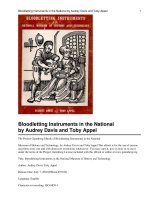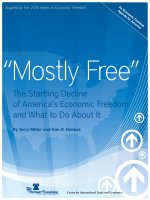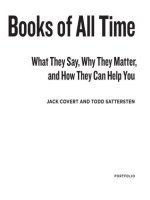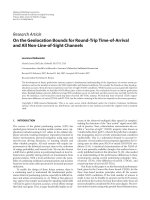Why the west rules for now the patterns of history, and what they reveal about the future
Bạn đang xem bản rút gọn của tài liệu. Xem và tải ngay bản đầy đủ của tài liệu tại đây (7.28 MB, 933 trang )
Tai Lieu Chat Luong
‘The nearest thing to a unified field theory of history we are ever likely to
get.Withwitandwisdom,IanMorrisdeploysthetechniquesandinsightsofthe
new ancient history to address the biggest of all historical questions: Why on
earthdidtheWestbeattheRest?Ilovedit.’NiallFerguson
‘This is a great work of synthesis and argument, drawing together an
awesomerangeofmaterialsandauthoritiestobringusafresh,sharpreadingof
East–West relationships. As China rises and the world’s population spikes,
Morris weaves lessons from thousands of years of world history towards a
startlingandscaryconclusion.’AndrewMarr
‘Ian Morris has returned history to the position it once held. No longer a
seriesofdustydebates,norsimplestories–althoughhehasmanystoriestotell
andtellsthembrilliantly–butthetruemagistervitae–the‘teacheroflife’.He
explains how the shadowy East–West divide came about, why it really does
matter,andhowonedayitmightendup.Hisvisionisdazzling,andhisprose
irresistible.EveryonefromSheffieldtoShanghaiwhowantstoknow,notonly
howtheycametobewhoandwheretheyare,butwheretheirchildrenandtheir
children’schildrenmightonedayendup,mustreadthisbook.’AnthonyPagden,
distinguished professor of political science and history at the University of
California, Los Angeles, author of Worlds and War: The 2,500 Year Struggle
BetweenEastandWest
‘Morris’shistoryofworlddominancesparklesasmuchwithexoticideasas
withextraordinarytales.WhyTheWestRules–ForNowisbotharivetingdrama
and a major step towards an integrated theory of history.’ Richard Wrangham,
Ruth Moore Professor of Biological Anthropology, Harvard University and
authorofCatchingFire
‘IanMorrisisaclassicalarchaeologist,anancienthistorianandawriterof
suchbreathtakingvisionandscopeastomakehimfittoberankedalongsidethe
likesofJaredDiamondandDavidLandes.Hismagnumopusisatournotjust
d’horizonbutdeforce,takingusasitdoesonaspectacularjourneytoandfrom
the two nodal cores of a euramerican West and Asian East, alighting and
reflecting as suggestively upon 10,800 BC as upon AD 2010. The shape of
globalisinghistorymaywellneverbequitethesameagain.’PaulCartledge,A.
G.LeventisProfessorofGreekCulture,UniversityofCambridge
‘This is an astonishing work: hundreds of pages of the latest information
dealingwitheveryaspectofchange.Then,thequestionsofthefuture:Whatwill
anewdistributionbringabout?WillEuropeundergoamajorchange?Willthe
millionsofimmigrantsimposeanewsetofrulesontherest?Therewasatime
when Europe could absorb any and all newcomers. Now the newcomers may
dictate the terms. The West may continue to rule, but the rule may be very
different.’DavidS.Landes,authorofTheWealthandPovertyofNations
‘Deeply thought-provoking and engagingly lively, broad in sweep and
precise in detail.’ Jonathan Fenby, author of The Penguin History of Modern
China,formereditoroftheObserverandSouthChinaMorningPost
‘Aformidable,richlyengrossingefforttodeterminewhyWesterninstitutions
dominatetheworld…Readerswillenjoy[Morris’s]livelyproseandimpressive
combination of scholarship … with economics and science. A superior
contribution to the grand-theory-of-human-history genre.’ Kirkus Reviews
(starredreview)
WHYTHEWESTRULES—FORNOW
WHY
WEST
RULES—FORNOW
________________________________
ThePatternsofHistory,
andWhat
TheyRevealAbout
theFuture
________________________________
IANMORRIS
FirstpublishedinGreatBritainin2010by
PROFILEBOOKSLTD
3AExmouthHouse
PineStreet
LondonEC1R0JH
www.profilebooks.com
FirstpublishedintheUnitedStatesofAmericain2010byFarrar,Strausand
Giroux
Copyright©IanMorris,2010
Mapsandgraphscopyright©MicheleAngel,2010
DesignedbyAbbyKagan
Themoralrightoftheauthorhasbeenasserted.
ThiseBookeditionpublishedin2010
Aportionofchapter11(‘WhytheWestRules…’)originallyappeared,in
slightlydifferentform,intheWallStreetJournal.
Gratefulacknowledgementismadeforpermissiontoreprintthefollowing
material:ExcerptfromMarkEdwardLewis’spartialtranslationofapoemby
CaoCao,reprintedbypermissionofthepublisherfromTheEarlyChinese
Empire:QinandHanbyMarkEdwardLewis;TimothyBrook,GeneralEditor
(Cambridge,Mass.:TheBelknapPressofHarvardUniversityPress),copyright
©2007bythePresidentandFellowsofHarvardCollege.ExcerptfromThe
FamilyInstructionsoftheGrandfatherfromtheCambridgeIllustratedHistory
ofChinabyPatriciaEbrey(NewYork:CambridgeUniversityPress,1996).
ReprintedbypermissionofCambridgeUniversityPress.
TranslationofDaoqian’s(TaoCh’ien’s)poem‘OntheWaytoGuizong
Monastery,’reprintedwithpermissionfromCommerceandSocietyinSung
ChinabyShibaYoshinobu(AnnArbor:CenterforChineseStudies,University
ofMichigan,1970).
DonaldB.Wagner’stranslationofexcerptsfrom‘StoneCoal’bySuShi,
fromhisarticletitled‘BlastFurnacesinSong-YuanChina’inEastAsian
Science,Technology,andMedicine,no.18(2001),pp.41–74.Reprintedby
permissionofDonaldB.Wagner.RichardStrassberg’stranslationofKong
Shangren’spoem‘TryingonGlasses,’fromMacao:MysteriousDecayand
RomancebyRonaldPittisandSusanHenders(eds.),reprintedbypermissionof
OxfordUniversitypress(China)Ltd.
Excerptfrom‘Here’fromCollectedPoemsbyPhilipLarkin,copyright©
1988,2003bytheestateofPhilipLarkin,reprintedbypermissionofFarrar,
StrausandGiroux,LLC,andFaberandFaberLtd.
ThiseBookiscopyrightmaterialandmustnotbecopied,reproduced,
transferred,distributed,leased,licensedorpubliclyperformedorusedinany
wayexceptasspecificallypermittedinwritingbythepublishers,asallowed
underthetermsandconditionsunderwhichitwaspurchasedorasstrictly
permittedbyapplicablecopyrightlaw.Anyunauthoriseddistributionoruseof
thistextmaybeadirectinfringementoftheauthor’sandpublisher’srightsand
thoseresponsiblemaybeliableinlawaccordingly.
ACIPcataloguerecordforthisbookisavailablefromtheBritishLibrary.
eISBN9781847652942
ForKathy
Contents
ListofIllustrations
Introduction
PARTI
1BeforeEastandWest
2TheWestTakestheLead
3TakingtheMeasureofthePast
PARTII
4TheEastCatchesUp
5NeckandNeck
6DeclineandFall
7TheEasternAge
8GoingGlobal
9TheWestCatchesUp
10TheWesternAge
PARTIII
11WhytheWestRules…
12…ForNow
Appendix:OnSocialDevelopment
Notes
FurtherReading
Bibliography
Acknowledgments
Index
Illustrations
Figure I.1. The Chinese junk Qiying in London, 1848. (Reproduced from
theIllustratedLondonNewsvolume12,April1,1848,p.222)
Figure I.2. The British ship Nemesis in action on the Yangzi River, 1842.
(National Maritime Museum. Copyright © National Maritime
Museum,Greenwich,London)
Figure1.1.LocationsmentionedinChapter1
Figure1.2.TheMoviusLine
Figure 1.3. The spread of modern humans out of Africa, 60,000–14,000
yearsago
Figure 1.4. The Altamira cave paintings. (Kenneth Garrett/National
GeographicImageCollection)
Figure1.5.FindsofcavepaintingsandportableartinEurope
Figure 1.6. The Hohle Fels “Venus” figurine. (Copyright © University of
Tübingen,photobyH.Jensen)
Figure2.1.LocationsmentionedinChapter2
Figure2.2.Temperaturesacrossthelast20,000years
Figure2.3.LocationsaroundtheHillyFlanksmentionedinChapter2
Figure2.4.ThespreadofagricultureacrossEurope,9000–4000BCE
Figure2.5.LucaCavalli-Sforza’smapofEuropeanDNA
Figure2.6.Theworld’scoresofdomestication
Figure2.7.LocationsinChinadiscussedinChapter2
Figure2.8.ThespreadofagricultureacrossEastAsia,6000–1500BCE
Table2.1.ThebeginningsofEastandWest,14,000–3000BCE
Figure3.1.EarlCook’sestimatesofenergyuseacrosshistory
Figure3.2.TherelocationsoftheEasternandWesterncoressincetheIce
Age
Figure3.3.Socialdevelopment,14,000BCE-2000CE
Figure3.4.Exponentialgrowthplottedonaconventionalgraph
Figure3.5.Interruptedexponentialgrowthplottedonaconventionalgraph
Figure3.6.Interruptedexponentialgrowthplottedonalog-lineargraph
Figure3.7.Socialdevelopment,14,000 BCE-2000CE,plottedonalog-linear
graph
Figure3.8.Theinterruptionstosocialdevelopment,1600BCE-1900CE
Figure3.9.Projectedsocialdevelopment,1700–2100CE
Figure4.1.Socialdevelopment,14,000–5000BCE
Figure4.2.Socialdevelopment,5000–1000BCE
Figure4.3.LocationsintheWestmentionedinChapter4
Figure4.4.TheWesternInternationalAgekingdoms,c.1350BCE
Figure4.5.LocationsintheEastmentionedinChapter4
Table4.1.MajorEasternandWesterncollapses,3100–1050BCE
Figure5.1.Socialdevelopment,1000–100BCE
Figure 5.2. Locations in the East dating 1000–500
Chapter5
BCE
mentioned in
Figure 5.3. Locations in the West dating 1000–500
Chapter5
BCE
mentioned in
Figure5.4.ClimatechangeintheearlyfirstmillenniumBCE
Figure5.5.TheAssyrianandPersianempires
Figure5.6.TheQinEmpire
Figure5.7.ThePersianandRomanempires
Figure5.8.RouteslinkingEastandWestinthelatefirstmillenniumBCE
Figure6.1.Socialdevelopment,100BCE-500CE
Figure6.2.ShipwrecksandleadpollutionintheMediterranean,900–1BCE
Figure6.3.ThegreatestextentoftheHanandRomanempires
Figure6.4.ThecollapseoftheHanEmpire,25–220CE
Figure6.5.TheRomanEmpireinthethirdcenturyCE
Figure6.6.ShipwrecksandleadpollutionintheMediterranean,1–800CE
Figure6.7.ThecollapseoftheRomanEmpire,376–476CE
Figure6.8.ThedividedkingdomsofEastandWest,400–500
Figure6.9.ThegrowthofChristianityandMahayanaBuddhism
Figure7.1.Socialdevelopment,300–1100
Figure7.2.(a)ThestatesofChinain541;(b)theTangEmpirein700
Figure 7.3. The Longmen Maitreya Buddha, carved around 700. (Werner
FormanArchive,London)
Figure7.4.ThewarsofJustinian,Khusrau,andHeraclius,533–628
Figure 7.5. Empress Theodora of Byzantium, 547. (Scala/Art Resource,
NY)
Figure7.6.TheArabconquests,632–732
Figure7.7.DivisionsintheWesterncore,100BCE–900CE
Figure 7.8. The eleventh-century migrations of the Seljuk Turks and
Vikings
Figure7.9.Chinaaround1000
Figure8.1.Socialdevelopment,1000–1500
Figure8.2.TheJurchenandSongempiresin1141
Figure8.3.TheMongolEmpire,1227–1294
Figure8.4.ZonesoftradeandtravelacrossEurasia,c.1300
Figure8.5.TheEasternandWesterncoresc.100and1200
Figure8.6.TheWesterncore,1350–1500
Figure8.7.Thefifteenth-centuryworldasseenfromChina
Figure8.8.Thefifteenth-centuryworldasseenfromEurope
Figure 8.9. Footbinding: the slippers and socks of Huang Sheng, 1243.
(TakenfromFujianshengbowuguan,ed.,FuzhouNan-SongHuang
sheng mu, published by Wenwu Chubanshe [Cultural Relics
PublishingHouse],Beijing,1982)
Figure8.10.Thefifteenth-centuryworldasseenfromAmerica
Figure9.1.Socialdevelopment,1400–1800
Figure9.2.LocationsinEastAsiamentionedinChapter9
Figure9.3.Wagesofunskilledurbanlaborers,1350–1800
Figure9.4.TheWesternempiresaround1550
Figure9.5.Theconquestofthesteppes,1650–1750
Figure9.6.EmpiresandtradearoundtheAtlantic,1500–1750
Figure9.7.Kangxi,emperorofChina,around1700.(Scala/Ministeroperi
BenieleAttivitaculturali/ArtResource,NY)
Figure9.8.TheWaroftheWest,1689–1815
Figure10.1.TheWest’snineteenth-centuryindustrialrevolution
Figure10.2.Socialdevelopment,1–2000CE
Figure10.3.WagesofunskilledlaborersinLondon,Florence,andBeijing,
1375–1875
Figure10.4.Globalizationinthenineteenthcentury
Figure10.5.OpiumsalesinGuangzhou,1730–1832
Figure10.6.AChineseviewofaBritishsailor,1839.(Copyright©Corbis)
Figure 10.7. “The Yellow Peril,” based on an 1895 sketch by Kaiser
WilhelmII.(AKGImages,London)
Figure10.8.Theworldatwar,1914–1991
Figure10.9.Theauthorandhistoys,1964.(Author’sphotograph,takenby
NoelMorris)
Figure10.10.ThehealthofU.S.Armyveterans,1910–1988
Figure10.11.EasternandWesternsocialdevelopmentcompared,1900and
2000
Figure 11.1. Social development, 14,000 BCE–2000 CE, plotted on a loglineargraph
Figure12.1.Projectedsocialdevelopment,1700–2100CE
Figure12.2.Instabilityandwatershortagesinthetwenty-firstcentury
FigureA.1.Energycapture,14,000BCE–2000CE
TableA.1.Energycapture,14,000BCE–2000CE
TableA.2.Citysize,7500BCE–2000CE
TableA.3.War-makingcapacity,3000BCE–2000CE
TableA.4.Informationtechnology,9300BCE–2000CE
Figure A.2. The implications of 10 percent margins of error in social
development
Figure A.3 The implications of 20 percent margins of error in social
development
WHYTHEWESTRULES—FORNOW
INTRODUCTION
ALBERTINBEIJING
London, April 3, 1848. Queen Victoria’s head hurt. She had been kneeling
with her face pressed to the wooden pier for twenty minutes. She was angry,
frightened, and tired from fighting back tears; and now it had started raining.
The drizzle was soaking her dress, and she only hoped that no one would
mistakehershiversforfear.
Herhusbandwasrightnexttoher.Ifshejuststretchedoutherarm,shecould
rest a hand on his shoulder, or smooth his wet hair—anything to give him
strength for what was coming. If only time would stand still—or speed up. If
onlysheandPrinceAlbertwereanywherebuthere.
And so they waited—Victoria, Albert, the Duke of Wellington, and half the
court—ontheirkneesintherain.Clearlytherewasaproblemontheriver.The
Chinese armada’s flagship was too big to put in at the East India Docks, so
GovernorQiyingwasmakinghisgrandentrytoLondonfromasmallerarmored
steamer named after himself, but even the Qiying was uncomfortably large for
the docks at Black-wall. Half a dozen tugs were towing her in, with great
confusionallaround.Qiyingwasnotamused.
OutofthecornerofhereyeVictoriacouldseethelittleChinesebandonthe
pier.Theirsilkrobesandfunnyhatshadlookedsplendidanhourago,butwere
nowthoroughlybedraggledintheEnglishrain.Fourtimesthebandhadstruck
upsomeOrientalcacophony,thinkingthatQiying’slitterwasabouttobecarried
ashore, and four times had given up. The fifth time, though, they stuck to it.
Victoria’s stomach lurched. Qiying must be ashore at last. It was really
happening.
And then Qiying’s envoy was right in front of them, so close that Victoria
couldseethestitchingonhisslippers.Therewerelittledragons,puffingsmoke
andflames.Itwasmuchfinerworkthanherownladies-in-waitingseemedable
todo.
Theenvoydronedon,readingtheofficialproclamationfromBeijing.Victoria
had been told what it said: that the Grand Exemplar the Cultured Emperor
Daoguang recognized the British queen’s desire to pay her respects to the
imperialsuzerainty;thatVictoriahadbeggedfortheopportunitytooffertribute
andtaxes,payingtheutmostobeisanceandaskingforcommands;andthatthe
emperoragreedtotreatherrealmasoneofhisinferiordomains,andtoallowthe
BritishtofollowtheChineseway.
ButeveryoneinBritainknewwhathadreallyhappened.AtfirsttheChinese
had been welcome. They had helped fund the war against Napoleon, who had
closedthecontinent’sportstothem.Butsince1815theyhadbeensellingtheir
goods at lower and lower prices in Britain’s ports, until they put Lancashire’s
cotton mills out of business. When the British protested and raised tariffs, the
ChineseburnedtheproudRoyalNavy,killedAdmiralNelson,andsackedevery
town along the south coast. For almost eight centuries England had defied all
conquerors, but now Victoria’s name would go down forever in the annals of
shame. Her reign had been an orgy of murder, rapine, and kidnapping; defeat,
dishonor,anddeath.AndherewasQiyinghimself,theevilarchitectofEmperor
Daoguang’swill,cometooozemorecantandhypocrisy.
AttheappropriatemomentVictoria’stranslator,kneelingjustbehindher,gave
a perfect courtier’s cough that only the queen could hear. This was the signal:
Qiying’s minion had reached the part about investing her as a subject ruler.
Victoriaraisedherforeheadfromthedockandsatuptoreceivethebarbariccap
and robe that signified her nation’s dishonor. She got her first good look at
Qiying. She did not expect to see such an intelligent- and vigorous-looking
middle-aged fellow. Could he really be the monster she had dreaded? And
Qiying got his first look at Victoria. He had seen a portrait of her at her
coronation, but she was even stouter and plainer than he had expected. And
young—very,veryyoung.Shewassoakedandappearedtohavelittlesplinters
andbitsofmudfromthedockalloverherface.Shedidnotevenknowhowto
kowtowproperly.Whatgracelesspeople!
And now came the moment of blackest horror, the unthinkable. With deep
bows,twomandarinssteppedfrombehindQiyingandhelpedAlberttohisfeet.
Victoriaknewsheshouldmakenosoundorgesture—andinverytruth,shewas
frozentothespot,andcouldnothaveprotestedhadshetried.
TheyledAlbertaway.Hemovedslowly,withgreatdignity,thenstoppedand
lookedbackatVictoria.Theworldwasinthatglance.
Victoriaswooned.AChineseattendantcaughtherbeforeshefelltothedock;
itwouldnotdotohaveaqueen,evenaforeigndevilqueen,hurtherselfatsuch
a moment. Sleepwalking now, his expression frozen and his breath coming in
gasps, Albert left his adopted country. Up the gangplank, into the luxurious
lockedcabin,andontoChina,theretobeinvestedasavassalintheForbidden
Citybytheemperorhimself.
By the time Victoria recovered, Albert was gone. Now, finally, great sobs
rackedherbody.ItcouldtakeAlberthalfayeartogettoBeijing,andthesame
togetback;andhemightwaitfurthermonthsoryearsamongthosebarbarians
untiltheemperorgrantedhimanaudience.Whatwouldshedo?Howcouldshe
protectherpeople,alone?HowcouldshefacethiswickedQiying,afterwhathe
haddonetothem?
Albertnevercameback.HereachedBeijing,whereheastonishedthecourt
withhisfluentChineseandhisknowledgeoftheConfucianclassics.Butonhis
heels came news that landless farm workers had risen up and were smashing
threshingmachinesalloversouthernEngland;andthenthatbloodystreetbattles
wereraginginhalfthecapitalsofEurope.Afewdayslatertheemperorreceived
aletterfromQiyingsuggestingthatitmightbebesttokeepatalentedprincelike
Albertsafelyoutofthecountry.Allthisviolencewasasmuchaboutthepainful
transition to modernity as about the Chinese Empire, but there was no point
takingchanceswithsuchturbulentpeople.
SoAlbertstayedintheForbiddenCity.HethrewawayhisEnglishsuitsand
grewaManchupigtail,andwitheachpassingyearhisknowledgeoftheChinese
classics deepened. He grew old, alone among the pagodas, and after thirteen
yearsinthegildedcage,hefinallyjustgaveupliving.
On the other side of the world Victoria shut herself away in under-heated
private rooms at Buckingham Palace and ignored her colonial masters. Qiying
simplyranBritainwithouther.Plentyoftheso-calledpoliticianswouldcrawlon
theirbelliestodobusinesswithhim.TherewasnostatefuneralwhenVictoria
diedin1901;justshrugsandwrysmilesatthepassingofthelastrelicoftheage
beforetheChineseEmpire.
LOOTYINBALMORAL
Inreality,ofcourse,thingsdidn’thappenthisway.Oratleast,onlysomeof
themdid.TherereallywasaChineseshipcalledtheQiying,anditreallydidsail
into London’s East India Docks in April 1848 (Figure I.1). But it was not an
ironclad gunboat carrying a Chinese governor to London: the real Qiyingwas
justagailypaintedwoodenjunk.BritishbusinessmenintheCrownColonyof
HongKonghadboughtthelittleboatacoupleofyearsbeforeanddecidedthatit
wouldbeajollyjapetosenditbacktotheoldcountry.
Queen Victoria, Prince Albert, and the Duke of Wellington really did come
downtotheriver,butnottokowtowbeforetheirnewmaster.Rather,theycame
astouriststogawkatthefirstChineseshipeverseeninBritain.
TheshipreallywasnamedafterthegovernorofGuangzhou.ButQiyinghad
not accepted British submission in 1842 after destroying the Royal Navy. In
reality, he negotiated China’s surrender that same year, after a small British
squadron sank every war junk it could find, silenced the coastal batteries, and
closed the Grand Canal linking Beijing to the rice-rich Yangzi Valley,
threateningthecapitalwithstarvation.
AndEmperorDaoguangreallydidruleChinain1848.ButDaoguangdidnot
tear Victoria and Albert apart: in fact the royal couple lived on in bliss,
punctuatedbyVictoria’smoods,untilAlbertdiedin1861.Therealitywasthat
VictoriaandAlberttoreDaoguangapart.
FigureI.1.TherealQiying:boatloadsofLondonersrowouttoseetheshipin
1848,asrecordedbyanartistfromtheIllustratedLondonNews.
Historyisoftenstrangerthanfiction.Victoria’scountrymenbrokeDaoguang
and shattered his empire for that most British of vices—a cup of tea (or, to be
precise,severalbillioncupsoftea).Inthe1790stheBritishEastIndiaCompany,
which ran much of South Asia as a private fiefdom, was shipping 23 million
poundsofChinesetealeavestoLondoneveryyear.Theprofitswereenormous,
but there was one problem: the Chinese government was not interested in
importingBritishmanufacturedgoodsinreturn.Allitwantedwassilver,andthe
company was having trouble raising enough to keep the trade going. So there
wasmuchjoywhenthetradersrealizedthatwhatevertheChinesegovernment
might want, the Chinese people wanted something else: opium. And the best
opium grew in India, which the company controlled. At Guangzhou—the one
Chinese port where foreigners could trade—merchants sold opium for silver,
used the silver to buy tea, then sold the tea for even greater profits back in
London.
As so often in business, though, solving one problem just created another.
IndiansateopiumandBritonsdissolveditanddrankit,consumingtentotwenty
tons every year (some of it going to calm babies). Both techniques produced
mildlynarcoticeffects,enoughtoinspiretheoddpoetandstimulateafewearls
anddukestonewdebaucheries,butnothingtoworryabout.TheChinese,onthe
otherhand,smokedit.Thedifferencewasnotunlikethatbetweenchewingcoca
leaves and lighting up a crack pipe. British drug dealers contrived to overlook
thisdifferencebutDaoguangdidnot,andin1839declaredwarondrugs.
Itwasanoddwar,whichquicklydegeneratedintoapersonalface-offbetween
Daoguang’s drug czar, Commissioner Lin Zexu, and the British superintendent
of trade at Guangzhou, Captain Charles Elliot. When Elliot realized he was
losing,hepersuadedthetraderstosurrenderastaggeringseventeenhundredtons
ofopiumtoLin;andhegotthetraderstoagreetothisbyguaranteeingthatthe
British government would reimburse them for their losses. The merchants did
notknowifElliotactuallyhadtheauthoritytopromisethis,buttheygrabbedthe
offer all the same. Lin got his opium; Elliot saved face and kept the tea trade
moving; and the merchants got top price (plus interest and shipping) for their
drugs.Everyonewon.
Everyone, that is, except Lord Melbourne, Britain’s prime minister.
Melbourne,whowasexpectedtofind£2milliontocompensatethedrugdealers,
didnotwin.Itshouldhavebeenmadnessforamerenavalcaptaintoputaprime
minister on the spot like this, but Elliot knew he could rely on the business
community to lobby Parliament to recover the money. And so it was that
personal, political, and financial interests thickened around Melbourne until he
had no choice but to pay up and then send an expedition to make the Chinese
governmentreimburseBritainfortheconfiscatedopium(FigureI.2).
This was not the British Empire’s finest hour. Contemporary analogies are
neverprecise,butitwasratherasifinresponsetotheU.S.DrugEnforcement
Agency making a major bust, the Tijuana cartel prevailed on the Mexican
government to shoot its way into San Diego, demanding that the White House
reimburse the drug lords for the street value of the confiscated cocaine (plus
interest and carriage charges) as well as paying the costs of the military
expedition.Imagine,too,thatwhileitwasintheneighborhood,aMexicanfleet
seizedCatalinaIslandasabaseforfutureoperationsandthreatenedtoblockade
WashingtonuntilCongressgavetheTijuanadruglordsmonopolyrightsinLos
Angeles,Chicago,andNewYork.
The difference, of course, is that Mexico is in no position to bombard San
Diego,whilein1839Britaincoulddowhateveritwanted.Britishshipsbrushed
asideChina’sdefensesandQiyingsignedahumiliatingtreaty,openingChinato
trade and missionaries. Daoguang’s wives were not carried off to London, the
way Albert went to Beijing in the scene I imagined at the beginning of this
introduction, but the “Opium War” broke Daoguang all the same. He had let
down300millionsubjectsandbetrayedtwothousandyearsoftradition.Hewas
righttofeellikeafailure.Chinawascomingapart.Addictionsoared,thestate
lostcontrol,andcustomcrumbled.
FigureI.2.Nottheirfinesthour:BritishshipsblowingChinesewarjunksout
oftheYangziRiverin1842.AtthefarrighttheNemesis,theworld’sfirstallironwarship,islivinguptoitsname.
Into this uncertain world came a failed civil service candidate named Hong
Xiuquan, who had grown up just outside Guangzhou. Four times Hong had
trekkedtothecitytotakethearduouscivilserviceentranceexams;fourtimeshe
had flunked. Finally, in 1843, he collapsed and had to be carried back to his
village. In his fevered dreams, angels took him up to heaven. There he met a
manwho,hewastold,washiselderbrother,andstandingshoulder-to-shoulder
thetwoofthembattleddemonsundertheirbeardedfather’sgaze.
No one in the village could make sense of this dream, and Hong seemed to
forget about it for several years, until one day he opened a little book he had
been given in Guangzhou on one of his trips to the examination hall. It
summarizedtheChristians’sacredtexts—and,Hongrealized,heldthekeytohis
dream.ThebrotherinhisdreamwasobviouslyJesus,whichmadeHongGod’s
Chineseson.HeandJesushadchasedthedemonsoutofheaven,butthedream
seemedtomeanthatGodwantedHongtoexpelthemfromearth,too.Patching
togetheramixofevangelicalChristianityandConfucianism,Hongproclaimeda
Heavenly Kingdom of Great Peace. Angry peasants and bandits flocked to his
banner.By1850hismotleycrewwasdefeatingthedisorganizedimperialarmies
sent against him, and he followed God’s will by introducing radical social
reforms. He redistributed land, legislated equal rights for women, and even
bannedfootbinding.
Intheearly1860s,whileAmericansslaughteredeachotherwithartilleryand
repeatingriflesintheworld’sfirstmodernwar,theChineseweredoingthesame
withcutlassesandpikesintheworld’slasttraditionalwar.Forsheerhorror,the
traditional version far outdid the modern one. Twenty million died, mostly
throughstarvationanddisease,andWesterndiplomatsandgeneralsexploitedthe
chaos to push farther into East Asia. In 1854, looking for coaling stations
between California and China, the American Commodore Perry forced Japan’s
portsopen.In1858Britain,France,andtheUnitedStateswonnewconcessions
from China. Emperor Xianfeng, who understandably hated the foreign devils
who had destroyed his father, Daoguang, and were now exploiting his war
against Hong, tried to wriggle out of the new treaty, but when Xianfeng got
difficult, the British and French governments made him an offer he couldn’t
refuse.TheymarchedonBeijingandXianfengbeatanundignifiedretreattoa
nearbyvacationspot.TheEuropeansthenburnedhisbeautifulSummerPalace,
lettinghimknowtheycoulddothesametotheForbiddenCityiftheyfeltlikeit,
andXianfengcavedin.Shatteredevenmorebadlythanhisfatherhadbeen,he
refusedtoleavehishidingplaceormeetwithofficialseveragain,andretreated
intodrugsandsex.Hediedayearlater.
Prince Albert expired just a few months after Xianfeng. Despite spending
years campaigning to persuade the British government that poor drains spread
disease, Albert probably died from typhoid carried through Windsor Castle’s
wretched sewers. Sadder still, Victoria—as deeply enamored of modern
plumbingasAlbert—wasinthebathroomwhenhepassedaway.
Robbed of the love of her life, Victoria sank deeper into moods and
melancholy. But she was not completely alone. British officers presented her
with one of the finest curiosities they had looted from the Summer Palace at
Beijing:aPekinesedog.ShenamedhimLooty.
LOCKINGIN
WhydidhistoryfollowthepaththattookLootytoBalmoralCastle,thereto
growoldwithVictoria,ratherthantheonethattookAlberttostudyConfuciusin
Beijing? Why did British boats shoot their way up the Yangzi in 1842, rather
thanChineseonesuptheThames?Toputitbluntly:WhydoestheWestrule?
To say the West “rules” might sound a little strong; after all, however we
define“theWest”(aquestionIwillreturntoinafewpages),Westernershave
notexactlybeenrunningaworldgovernmentsincethe1840s,andregularlyfail
to get their own way. Many of us are old enough to remember America’s
ignominious scramble out of Saigon (now Ho Chi Minh City) in 1975 and the
wayJapanesefactoriesdroveWesternrivalsoutofbusinessinthe1980s.Even
moreofusnowhavethesensethateverythingwebuyismadeinChina.Yetitis
alsoobviousthatinthelasthundredyearsorsoWesternershaveshippedarmies
toAsia,nottheotherwayaround.EastAsiangovernmentshavestruggledwith
Western capitalist and Communist theories, but no Western governments have
triedtoruleonConfucianorDaoistlines.Easternersoftencommunicateacross
linguisticbarriersinEnglish;EuropeansrarelydosoinMandarinorJapanese.
AsaMalaysianlawyerbluntlytoldtheBritishjournalistMartinJacques,“Iam
wearing your clothes, I speak your language, I watch your films, and today is
whateverdateitisbecauseyousayso.”
The list could go on. Since Victoria’s men carried off Looty the West has
maintainedaglobaldominancewithoutparallelinhistory.
Mygoalistoexplainthis.
Atfirstglance,itmightnotlooklikeIhavesetmyselfaverydifficulttask.
Nearly everyone agrees that the West rules because the industrial revolution
happenedthere,notintheEast.IntheeighteenthcenturyBritishentrepreneurs
unleashedtheenergiesofsteamandcoal.Factories,railroads,andgunboatsgave
nineteenth-century Europeans and Americans the ability to project power
globally; airplanes, computers, and nuclear weapons allowed their twentiethcenturysuccessorstocementthisdominance.
Thisdidnotmeanthateverythinghadtoturnoutexactlyasitdid,ofcourse.
If Captain Elliot had not forced Lord Melbourne’s hand in 1839, the British
might not have attacked China that year; if Commissioner Lin had paid more
attentiontocoastaldefenses,theBritishmightnothavesucceededsoeasily.But
itdoesmeanthatirrespectiveofwhenmatterscametoaheadandofwhosaton
thethrones,wontheelections,orledthearmies,theWestwasalwaysgoingto
win in the nineteenth century. The British poet and politician Hilaire Belloc
summeditupnicelyin1898:
Whateverhappenswehavegot
TheMaximGun,andtheyhavenot.
Endofstory.
Except, of course, this is not the end of the story. It just prompts a new
question:WhyhadtheWestgottheMaximgunwhentheresthadnot?Thisis
thefirstquestionIaddress,becausetheanswertellsuswhytheWestrulestoday;
and,armedwiththeanswer,wecanposeasecondquestion.Oneofthereasons
people care about why the West rules is that they want to know whether, how
long,andinwhatwaysthiswillcontinue—thatis,whatwillhappennext.
Thisquestiongrewincreasinglypressingasthetwentiethcenturyworeonand
Japan emerged as a major power; and in the early twenty-first it has become
unavoidable. China’s economy doubles in size every half-dozen years and will
probably be the world’s largest before 2030. As I write, in early 2010, most
economistsarelookingtoChina,nottheUnitedStatesorEurope,torestartthe









